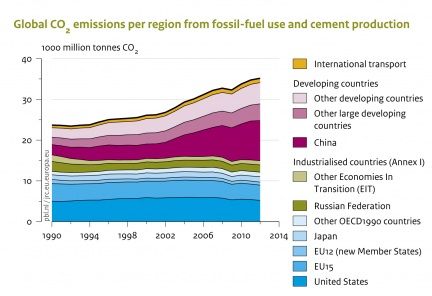According to a new report, worldwide carbon emissions slackened for the first time in 2012, raising the question – might this be the start of a global slowdown?
While the global emissions of carbon dioxide (CO2) reached a record 34.5 billion tonnes in 2012, this is an increase on the year before of only 1.1%, which is less than half the 2.9% average annual increase of the previous decade.
These estimates, by the PBL Netherlands Environmental Assessment Agency and the European Commissionís Joint Research Centre (JRC), were published online recently in their Trends in global CO2 emissions: 2013 report.
The report authors suggest the slackening in emissions for 2012 signals a shift from fossil fuels toward greater use of renewable energy and increased energy saving.
China, US and EU responsible for over half of worldwide carbon emissions
The report declares that three countries or regions of the world remain responsible for over half (55%) of total CO2 emissions – China (29%), United States (16%) and the European Union (11%) – and notes:
- Of these, China is the only one to see an increase in CO2 emissions, of 3%, but this is much lower than the 10% annual rises the country has seen in the last 10 years.
- In the US, CO2 emissions fell by 4%, reflecting a further shift from coal to gas in power generation.
- In the EU, CO2 emissions fell by 1.6%, largely because of a fall in gas and oil energy use, and a reduction in road freight.
- China has similar CO2 emissions per head of population as the EU and half that of the US – however, in relation to gross domestic product (GDP), China’s emissions per USD of GDP are nearly double those of the EU and the US, and more aligned with that of the Russian Federation.
Is this a sign of a more permanent slowdown? It depends …
The report suggests that the smaller global increase of 1.1% in 2012 (which includes a downward correction of 0.3% to take into account the leap year effect) may be “the first sign of a more permanent slowdown in the increase of global CO2 emissions, and ultimately of declining global emissions.”
But, say the authors, this may well depend on whether:
- China hits its own target for maximum energy use in 2015 and shift to gas with a natural gas content of 10% by 2020,
- The US continues to shift consumption toward gas and renewable energy, and
- The EU further reduces in emissions, which will require member states agreeing to restore the effectiveness of the EU Emissions Trading System.
Renewable energy is on the up
The report notes an accelerated growth in renewable energy, with the primary suppliers all showing continuous increases over the last 10 years. That is except for nuclear energy, which fell since 2012 in the aftermath of the March 2011 Fukushima Daiichi nuclear disaster.
Other forms of renewables have increased rapidly since 2002. From 2011 to 2012, hydropower output went up by 4.3%, while the proportion of renewable energy coming from newer sources like solar, wind and biofuel has also progressed at an accelerated pace that has doubled to 2.4% in the last 6 years (before that it took 15 years for it to double).
The authors drew on the Emissions Database for Global Atmospheric Research (EDGAR) and other sources to calculate their estimates.
In another report published recently the World Bank said all countries in East Asia stand to benefit from following a low-carbon growth path, and urged their governments to act now to unlock private investment in clean energy.
According to the European Union, carbon trading has been on the increase since 2005, and the trading bloc is set for a significant emissions reduction by 2020 and 2030 compared to 2005.


